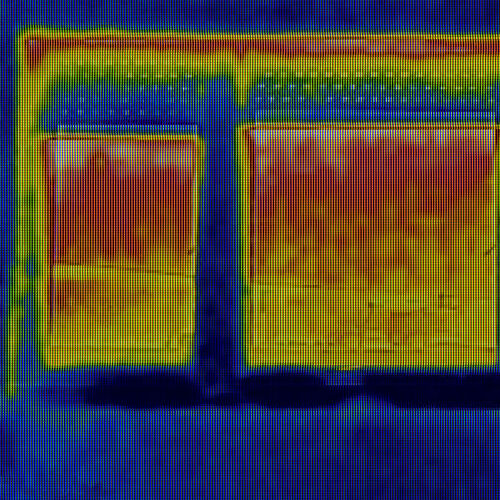
What is a blower door?
As a homeowner, you want every aspect of your homes essential components to be at their full capacity, especially the HVAC system. You’ve upgraded the system and upgraded the insulation, new windows, and doors. How can you be sure you’re getting the most out of all that work and money? A blower door test will tell you everything you want to know and things you should know about the air tightness of your home.
A blower door is a powerful fan that is affixed into a door frame to the exterior and pulls air out of your home. This lowers the inside air pressure and increased outside air pressure flows through any cracks or openings. An energy audit may include using a smoke pencil to air leak detection with a blower door test. These are places where air conditioned or heated air is escaping and that is a loss of your money!
What is a blower door used for?
A blower door test is used in energy audits and has become a common part of testing a home’s code compliance looking for air leaks in new construction. The thought behind this type of testing is to determine the quality of the construction, hence, if there are a lot air leaks, it is made of poor construction.
Using a blower door test for an energy audit is to help a homeowner know where their cool air in the summer and warm air in the winter is escaping. Once you know where the leaks are, you can make the additions and repairs needed to fix them.
Why is a blower door needed?
You’ve probably heard older, retired carpenters say that a house needs to breathe. Today, a scientist would argue with that after doing years of research. When a home has an uncontrolled air leakage, there are downsides that are more dangerous than not being airtight, one being the moisture build up that air leaks allow.
Moisture build up in a home can cause long-term health issues and aggravate existing health issues like allergies and asthma. With a blower door test, the leaks that allow moisture to gather inside walls, in the roof, and condense on cold surfaces are found and steps can be done to seal those places. The moisture build up is in addition to the amount of energy leaking from a home during cold winters and hot summers.
What does a blower door test measure?
You’ve had a blower door test and not sure what to take from all the numbers? You were concerned about some issues about your home’s energy efficiency, or lack of, and head that this blower door test could tell you where there were problem areas. Now that the energy auditor has come, performed the test, and left, after giving you a page of information with lots of numbers, what do they mean?
These number can be confusing, but it is critical to understand what the blower door test found for your home. There are several guideline standards on the values and what they could mean about your home. This article will strictly focus on the ACH50 results that we obtained for your house.
- Results: ACH50 less than 5.0 = A Tight House
- Results: ACH50 between 5.0 and 10.0 = A Moderate House
- Results: ACH50 above 10.0 = A Leaky House
Still confused? The Blower Door Test is telling you how energy efficient and well-sealed your home is and where the problem air leaks are located, including bad weatherstripping. So, don’t let the numbers lose you, they are nothing more than a reference point where you need to get started in tightening up your house. The blower door test results will tell you if there is air leaking around the doors, or windows, or the attic, maybe the crawl space is a culprit of energy loss.
How long does a blower door test take?
The preparation and the breakdown for the blow door test takes longer than the test. The set up can take between 90 minutes and two hours, depending on the size of our house. The test itself can take between ten to twenty minute and the breakdown another hour.
Is a blower door test worth it?
If you are upgrading your home, a blower door test will provide you information whether your house is energy efficient and how good or poor the indoor air quality. If your home has minimal number of air leaks, the energy auditor may recommend purchasing an ERV (energy recover ventilator) or heat recovery ventilator that will pull fresh air in and exchange stale cool or heated interior air without any loss of coolness or heating.

How do you install a blower door?
A blower door test unit is a versatile building tool that can provide diagnostics that can be helpful for a homeowner. There are professionals that are trained in setting up, performing, and reading the test, but a homeowner can do it themselves as well.
The Preparation:
Turn off all combustionable appliances so the blower door unit doesn’t cause a backdraft that will bring carbon monoxide inside the house. Any open flames or hot embers outside should be put out so they aren’t sucked into the house as well.
Now, walk around your house, making sure all the exterior doors and all the windows are closed. Make sure the interior doors are all opened and open the access to the basement. Any bath fans, exhaust fans, and the range hood should be turned off.
The Basic Airtight Test:
Following the instructions, assemble the aluminum frame so that it fits the opening and connect the fabric panels to the aluminum extrusions, then attach the Velcro tabs to the panel. Place the door panel snug into the door with locking knobs. Run the green tube out through the hole in the fabric panel place the fan in the elastic hole.
With the end facing away from the airstream and wind of the fan, using the flow rings facing into the home and with the speed controller hanging on the frame, plug it into the fan and the plug the cord into an outlet.
and plug the speed controller into the fan. Connect the power cord to an outlet. The baseline is established for the manometer using the kit’s instructions.
We’ve discussed the blower door advantages, but like anything else, are there any disadvantages to a blower door? A blower door test won’t provide accurate results on an older home that hasn’t been updated. An older home typically has a subflooring with 1×6 boards over a basement or crawlspace. For the blower door test to provide an accurate reading, the floor should be sprayed with foam for a flash coating or as insulation. Call 817-781-8781 today!



















